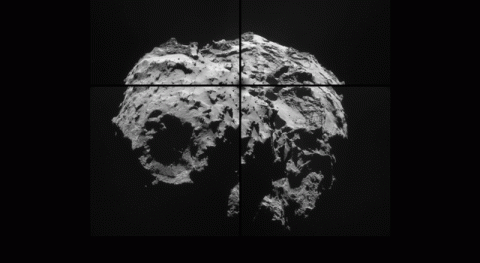Written by DC Agle
NASA’s Jet Propulsion Laboratory
 Pasadena, CA – There has been a significant increase in the amount of water “pouring” out of comet 67P/Churyumov-Gerasimenko, the comet on which the Rosetta mission’s Philae lander touched down in November 2014.
Pasadena, CA – There has been a significant increase in the amount of water “pouring” out of comet 67P/Churyumov-Gerasimenko, the comet on which the Rosetta mission’s Philae lander touched down in November 2014.
The 2.5-mile-wide (4-kilometer) comet was releasing the earthly equivalent of 40 ounces (1.2 liters) of water into space every second at the end of August 2014. The observations were made by NASA’s Microwave Instrument for Rosetta Orbiter (MIRO), aboard the European Space Agency’s Rosetta spacecraft. Science results from the MIRO team were released today as part of a special Rosetta-related issue of the journal Science.

The MIRO instrument is a small and lightweight spectrometer that can map the abundance, temperature and velocity of cometary water vapor and other molecules that the nucleus releases. It can also measure the temperature up to about one inch (two centimeters) below the surface of the comet’s nucleus.
One reason the subsurface temperature is important is that the observed gases likely come from sublimating ices beneath the surface. By combining information on both the gas and the subsurface, MIRO will be able to study this process in detail.
Also in the paper released today, the MIRO team reports that 67P spews out more gas from certain locations and at certain times during its “day.” The nucleus of 67P consists of two lobes of different sizes (often referred to as the “body” and “head” because of its duck-like shape), connected by a neck region. A substantial portion of the measured outgassing from June through September 2014 occurred from the neck region during the afternoon.
“That situation may be changing now that the comet is getting warmer,” said Gulkis. “MIRO observations would need to be carefully analyzed to determine which factors in addition to the sun’s warmth are responsible for the cometary outgassing.”
Observations are continuing to search for variability in the production rate and changes in the parts of the nucleus that release gas as the comet’s distance from the sun changes.
In another 67P paper released today, it was revealed that the comet’s atmosphere, or coma, is much less homogenous than expected and that comet outgassing varies significantly over time.
“If we would have just seen a steady increase of gases as we closed in on the comet, there would be no question about the heterogeneity of the nucleus,” said Myrtha Hässig, a NASA-sponsored scientist from the Southwest Research Institute in San Antonio. “Instead we saw spikes in water readings, and a few hours later, a spike in carbon dioxide readings. This variation could be a temperature effect or a seasonal effect, or it could point to the possibility of comet migrations in the early solar system.”
The measurements on the coma were made by the Rosetta Orbiter Spectrometer for Ion and Neutral Analysis Double Focusing Mass Spectrometer (ROSINA DFMS) instrument. Measuring the in situ coma composition at the position of the spacecraft, ROSINA data indicate that the water vapor signal is strongest overall. However, there are periods when the carbon monoxide and carbon dioxide abundances rival that of water.
“Taken together, the MIRO outgassing results and results about heterogeneous fountains from ROSINA suggest fascinating new details to be learned about how comets work,”said Claudia Alexander, NASA project scientist for the U.S. Rosetta team, from JPL. “These results are helping us move the field forward on how comets operate on a fundamental level.”
Rosetta is currently about 107 million miles (171 million kilometers) from Earth and about 92 million miles (148 million kilometers) from the sun. Comets are time capsules containing primitive material left over from the epoch when the sun and its planets formed.
By studying the gas, dust and structure of the nucleus and organic materials associated with the comet, via both remote and in situ observations, the Rosetta mission should become a key to unlocking the history and evolution of our solar system, as well as answering questions regarding the origin of Earth’s water and perhaps even life.
Rosetta is an ESA mission with contributions from its member states and NASA. Rosetta’s Philae lander is provided by a consortium led by the German Aerospace Center, Cologne; Max Planck Institute for Solar System Research, Go?ttingen; French National Space Agency, Paris; and the Italian Space Agency, Rome. JPL, a Division of the California Institute of Technology, Pasadena, manages the U.S. contribution of the Rosetta mission for NASA’s Science Mission Directorate in Washington.
JPL also built the MIRO and hosts its principal investigator, Samuel Gulkis. The Southwest Research Institute (San Antonio and Boulder), developed the Rosetta orbiter’s IES and Alice instruments, and hosts their principal investigators, James Burch (IES) and Alan Stern (Alice).
For more information on the U.S. instruments aboard Rosetta, visit: http://rosetta.jpl.nasa.gov
More information about Rosetta is available at: http://www.esa.int/rosetta


